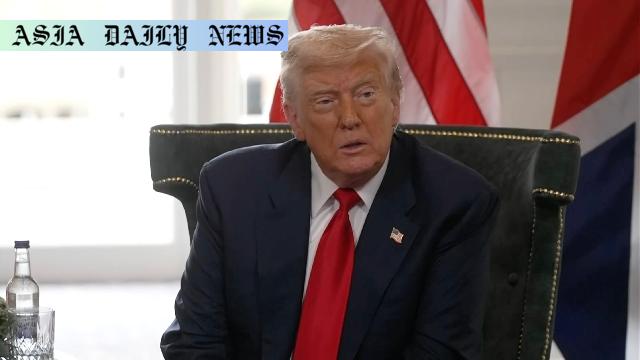Ceasefire: Trump shortens Russia’s ceasefire deadline, threatening sanctions and secondary tariffs for non-compliance.
- US President Trump has expedited Russia’s ceasefire deadline with Ukraine to just 10-12 days.
- Sanctions and secondary tariffs targeting nations transacting with Russia loom as potential penalties.
- Ukraine’s President Zelenskyy welcomes Trump’s decision as timely and crucial for peace progress.
- Former Russian President Medvedev warns that the ultimatum could escalate tensions.

Trump Speeds Up Ceasefire Deadline for Russia
Amid escalating tensions between Russia and Ukraine, US President Donald Trump has made a decisive move by shortening the deadline for Russia to agree to a ceasefire. Initially, Trump had allowed a 50-day period during which Russian President Vladimir Putin was urged to commit to peace talks. However, during his recent visit to Scotland, Trump announced a dramatic revision, reducing the time frame to just 10-12 days. This bold decision stems from Trump’s growing frustration over the lack of progress toward peace.
In his public remarks, Trump highlighted the urgency of immediate action, expressing his disappointment in the lack of meaningful steps taken by Moscow. He acknowledged the toll of the ongoing conflict, emphasizing that continued inaction is unacceptable in the face of mounting humanitarian consequences. ‘I want to be generous, but we’re not seeing any progress being made,’ he admitted. With this stern ultimatum, the US leader is prioritizing swift diplomatic resolutions over prolonged negotiations that yield little tangible result.
The Threat of Sanctions and Secondary Tariffs
President Trump underscored that failure to meet the new deadline would trigger severe economic consequences. The measures under consideration include sanctions on Russia as well as ‘secondary tariffs’ targeting countries that purchase Russian products, thereby creating a broad, multi-target strategy. These moves are part of a larger effort to economically and politically pressure Moscow into compliance.
This dramatic shift signals a step toward punitive diplomacy, a method frequently employed by the Trump Administration to enforce foreign policy goals. Secondary tariffs, which impact not only Russia but also its trading partners, extend the reach of American sanctions. Furthermore, Trump’s decision signals his belief that targeted economic pain may provide the necessary leverage to induce change and compel Russian leaders to adopt a more collaborative stance with Ukraine.
Reactions from Ukraine and Russia
Ukrainian President Volodymyr Zelenskyy responded positively to the adjusted timeline, praising the US president for his decisive and forceful approach. He emphasized that ‘timely action accelerates the peace process while encouraging global accountability for Russian transgressions.’ Zelenskyy has been firm in his belief that strength and global solidarity are crucial in resolving the conflict with Russia. His commendation of Trump’s leadership underscores a united front between Ukraine and the United States.
The Kremlin, however, reacted with hostility. Former Russian President Dmitry Medvedev addressed the move on social media, accusing Trump of ‘playing the ultimatum game’ and declaring that such actions escalate the potential for broader conflicts. Medvedev charged that ultimatums do not pave the way for peace, suggesting instead that they risk provoking a deeper geopolitical crisis. This culminates in a complex international scenario where diplomatic desertion and escalating rhetoric threaten to unravel progress toward sustainable peace.
The Global Implications of a Tightened Deadline
Trump’s revised timeline and his firm stance reflect a strategic pivot toward harsher measures to enforce peace. Although the situation remains fluid, the decision mirrors a larger global trend wherein ultimatums and rapid deadlines are wielded as critical tools in international diplomacy. Reducing the vector of delay frequently employed during negotiations, albeit high-risk, establishes accountability among participants.
Ultimately, the success of Trump’s approach will depend on the extent of global cooperation and the willingness of allied nations to embrace secondary sanctions against Russia. Time will tell whether the narrower deadline yields substantial outcomes, as the global community keenly observes developments in the fragile Ukraine-Russia conflict. If successful, this strategy may not only restore geopolitical stability but could also fundamentally reshape international norms governing conflict resolution.



Commentary
Trump’s Strategy: A Calculated Risk
President Trump’s decision to tighten the ceasefire deadline with Russia demonstrates a bold, high-stakes strategy that has both its merits and its risks. The move reflects his administration’s commitment to taking decisive action on global issues, particularly when diplomacy has failed to produce tangible results. However, this approach also opens the door to potential escalation, as seen in Russia’s dismissive reaction to the ultimatum.
The use of sanctions and tariffs as bargaining tools is not new to American foreign policy, but Trump’s incorporation of secondary tariffs introduces a broader scope of influence. By targeting trade partners of Russia, the US is sending a powerful message that their actions have wide-ranging consequences. This could prompt reluctant stakeholders to consider stronger measures against Moscow, potentially strengthening international alliances. However, this could also alienate neutral parties and introduce further complexity in global trade relations.
Implications for Global Leadership
Trump’s latest move positions the United States as a dominant force in seeking resolution to the Ukraine crisis, reinforcing its image as a global peace broker. His decision resonates with allies like Ukraine, who view it as a much-needed intervention. Yet, it also risks exacerbating tensions with adversaries like Russia, which remains unwilling to yield to what it considers ‘Western coercion.’
Balancing strength with diplomacy is a delicate art, and the success or failure of Trump’s approach will have long-lasting implications. Should this aggressive timeline yield results, it could set a precedent for future conflicts. However, if it escalates tensions without achieving a ceasefire, the political fallout could be significant for all parties involved.